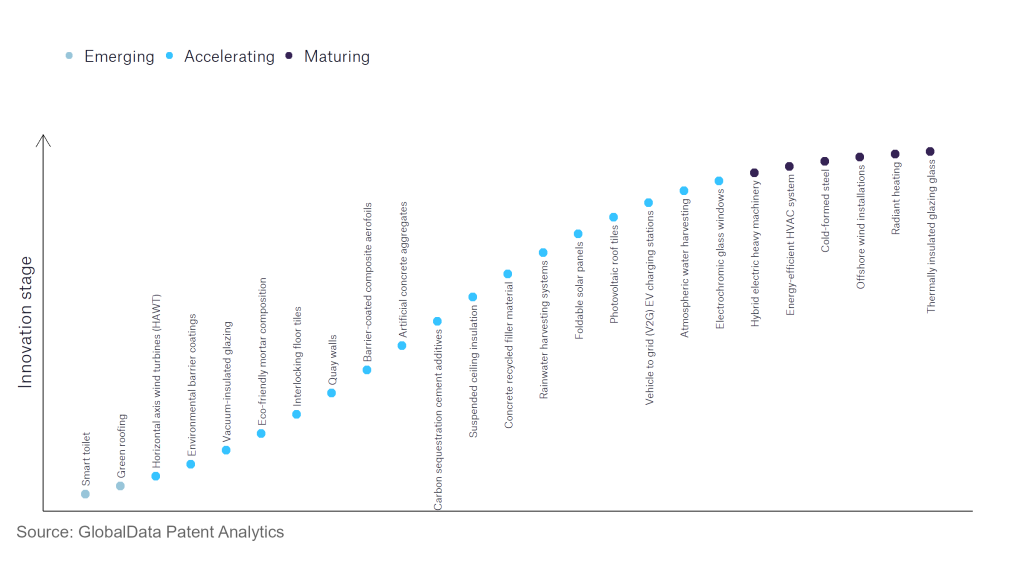The construction industry continues to be a hotbed of innovation, with activity driven by an increased focus on environmental sustainability, workplace safety and circular construction, and the growing importance of technologies such as the Internet of Things, robotics and improved construction materials. In the last three years alone, there have been over 248,000 patents filed and granted in the construction industry, according to GlobalData’s report on Environmental sustainability in Construction: Energy-efficient HVAC system. Buy the report here.
However, not all innovations are equal and nor do they follow a constant upward trend. Instead, their evolution takes the form of an S-shaped curve that reflects their typical lifecycle from early emergence to accelerating adoption, before finally stabilising and reaching maturity.
Identifying where a particular innovation is on this journey, especially those that are in the emerging and accelerating stages, is essential for understanding their current level of adoption and the likely future trajectory and impact they will have.
80+ innovations will shape the construction industry
According to GlobalData’s Technology Foresights, which plots the S-curve for the construction industry using innovation intensity models built on over 179,000 patents, there are 80+ innovation areas that will shape the future of the industry.
Within the emerging innovation stage, green roofing is a disruptive technology that is in the early stages of application and should be tracked closely. HAWT wind turbines, environmental barrier coatings, and vacuum-insulated glazing are some of the accelerating innovation areas, where adoption has been steadily increasing. Among maturing innovation areas are hybrid electric heavy machinery and energy-efficient HVAC system, which are now well established in the industry.
Innovation S-curve for environmental sustainability in the construction industry

Energy-efficient HVAC system is a key innovation area in environmental sustainability
A heating, ventilation and air conditioning system, or HVAC, is a means to control the ambient conditions within an enclosed space. Given their substantial energy requirements during warmer periods, HVAC systems contribute significantly to global warming, driving the need to maximise their energy efficiency. Efficient HVAC systems can be achieved through both design and use, taking advantage of methods such as demand-controlled ventilation or designs that utilise waste heat to warm air or natural moisture to cool air.
GlobalData’s analysis also uncovers the companies at the forefront of each innovation area and assesses the potential reach and impact of their patenting activity across different applications and geographies. According to GlobalData, there are 150+ companies, spanning technology vendors, established construction companies, and up-and-coming start-ups engaged in the development and application of Energy-efficient HVAC system.
Key players in energy-efficient HVAC system – a disruptive innovation in the construction industry
‘Application diversity’ measures the number of different applications identified for each relevant patent and broadly splits companies into either ‘niche’ or ‘diversified’ innovators.
‘Geographic reach’ refers to the number of different countries each relevant patent is registered in and reflects the breadth of geographic application intended, ranging from ‘global’ to ‘local’.
Patent volumes related to energy-efficient HVAC system
Source: GlobalData Patent Analytics
Leading innovators in the development of energy-efficient HVAC systems include Midea Holding and Mitsubishi Electric. A key patent filed by Midea Holding in the energy-efficient HVAC systems space includes a cold-air-avoidance control method, which improves the reliability and accuracy of the control of the heating indoor unit such that the effect of the cold-air-avoidance control is improved. Key innovations by Mitsubishi Electric include an air-conditioning system control device and an air-conditioning system control method that are capable of increasing the operating efficiencies of the air-conditioning apparatus while controlling a change in the room temperature within a predetermined range, allowing energy-saving operation while keeping an air-conditioned space in a comfortable state.
Companies leading in terms of application diversity include HUNTAIR, a manufacturer of commercial air handlers and cleanroom ceiling systems, and Mitsubishi Heavy Industries, a manufacturer of a diverse range of heavy machinery, including air-conditioning systems. In terms of geographical reach, Dyson Holdings and Delta-T lead the space.
To further understand the key themes and technologies disrupting the construction industry, access GlobalData’s latest thematic research report on Construction.
Data Insights
From

The gold standard of business intelligence.
Blending expert knowledge with cutting-edge technology, GlobalData’s unrivalled proprietary data will enable you to decode what’s happening in your market. You can make better informed decisions and gain a future-proof advantage over your competitors.



